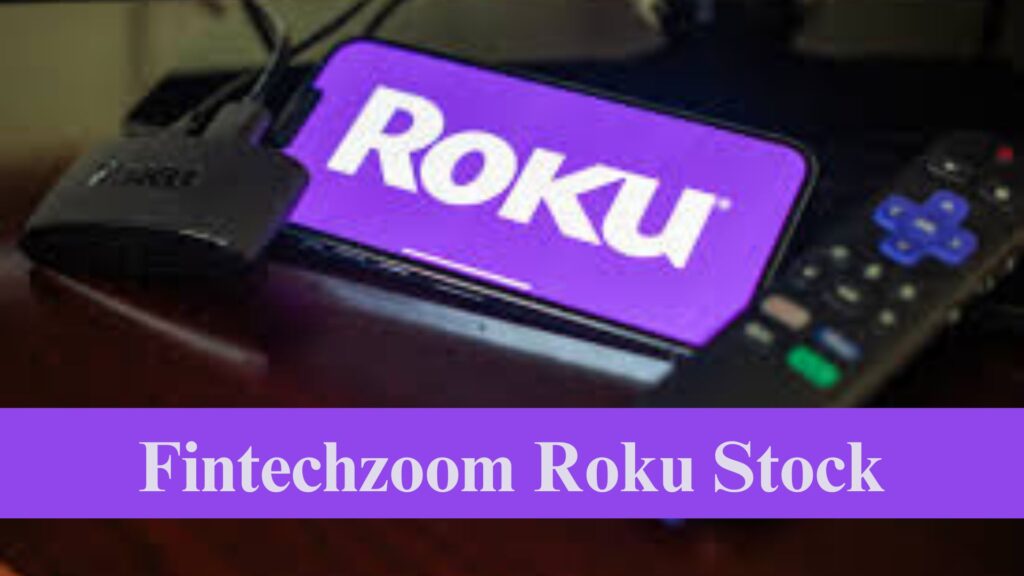Fintechzoom Roku stock has been a hot topic in the investment world lately, with its price displaying considerable volatility stemming from dynamic market conditions. As investors navigate through these uncertain times, understanding the factors driving this volatility and developing strategies to capitalize on it is crucial. In this blog post, we will delve into the intricacies of Fintechzoom Roku stock, analyze its revenue growth, assess the impact of market conditions, and provide insights on forecasting the future of this stock. Additionally, we will explore investment strategies that can help investors navigate through the unstable market conditions surrounding Roku stock.
Understanding the Volatility of Fintechzoom Roku Stock
The volatility surrounding Fintechzoom Roku stock is a complex phenomenon, intertwined with an array of internal and external factors that influence its market performance. Internally, Roku’s own business metrics, including shifts in user engagement, changes in market share, and revenue fluctuations, play a pivotal role in shaping its stock price movements. These elements are direct reflections of the company’s operational success and strategic decisions, which can either fuel optimism or concern among investors, thus impacting stock volatility.
Externally, broader economic indicators and global market sentiments exert a significant influence on Fintechzoom Roku stock’s stability. For instance, changes in interest rates, inflation data, and employment statistics can sway investor confidence broadly, affecting tech stocks, including Roku. Moreover, industry-specific trends, such as shifts towards streaming services, regulatory changes affecting digital advertising, and competition dynamics, are critical in determining Roku’s position in the market and, by extension, its stock performance.
Another layer adding to Roku’s stock volatility is investor sentiment, which can be incredibly reactive to news, rumors, and forecasts. Announcements regarding partnerships, product launches, or quarterly earnings reports can lead to immediate and sharp price movements as investors rush to adjust their positions based on new information. This reactivity is compounded by the fact that Roku operates in the highly volatile tech sector, known for its rapid innovation cycles and competitive pressures.
It is also worth noting the role of speculative trading in exacerbating stock volatility. Traders looking to capitalize on short-term price movements may contribute to increased volatility through their frequent buying and selling actions, influenced by technical analysis, market rumors, or momentum trading strategies.
In understanding the volatility of Fintechzoom Roku stock, investors must consider this interplay of internal performance metrics, external economic and industry conditions, and market sentiment, all of which collectively contribute to the stock’s price fluctuations. This comprehensive approach enables investors to navigate the complex landscape surrounding Roku’s market performance more effectively.
Analyzing Roku’s Strategic Revenue Growth
Roku’s impressive trajectory in revenue growth is largely attributable to its innovative strategies in user base expansion and platform monetization. The company has adeptly harnessed the advertising market, recognizing the shifting dynamics where advertisers are increasingly drawn to connected TV platforms. This shift positions Roku favorably, allowing it to capture a significant share of advertising revenues. Its approach has been multi-faceted, not only focusing on the advertising spectrum but also on enhancing hardware sales and pushing its subscription services. These avenues have collectively contributed to a robust revenue stream for Roku.
The essence of Roku’s strategic growth lies in its ability to adapt and innovate. For instance, the company’s investment in advanced advertising technologies has made it an attractive platform for advertisers seeking targeted and measurable ad campaigns. This is crucial in an era where digital advertising efficacy is paramount. Additionally, Roku’s user interface and personalized content recommendations have played pivotal roles in retaining and expanding its user base, thereby ensuring a steady inflow of advertising and subscription revenues.
Moreover, Roku has also capitalized on strategic partnerships and content agreements to enrich its offering. These collaborations not only enhance the value proposition for its users but also open up additional revenue streams. Whether it’s through exclusive content deals, expanded library offerings, or integrated advertising solutions, Roku demonstrates a keen understanding of the evolving digital landscape.
By focusing on these strategic pillars, Roku has not only solidified its position in the competitive streaming market but also set the foundation for sustainable revenue growth. Its ability to navigate the intricacies of digital advertising, coupled with a relentless pursuit of user engagement and satisfaction, underpins the company’s financial success.
The Impact of Market Conditions on Roku Stock
The fluctuating nature of the stock market, influenced heavily by macroeconomic factors and geopolitical events, plays a significant role in the movement of Fintechzoom Roku stock prices. Economic downturns, fluctuations in interest rates, and political unrest can prompt a knee-jerk reaction from investors, leading to increased sell-offs and, consequently, heightened volatility for Roku’s shares. The performance of Roku stock is not immune to these broader market forces, which can overshadow even the company’s strong financials or growth prospects during periods of widespread market pessimism or euphoria.
Moreover, the tech sector, where Roku operates, is particularly sensitive to shifts in investor sentiment, often reacting more dramatically to market-wide trends than other industries. For instance, regulatory changes aimed at big tech companies, though not directly targeting Roku, can create an environment of uncertainty that affects its stock. Similarly, the Federal Reserve’s policies on interest rates can impact investor appetite for growth stocks like Roku, as these policies influence the broader economic landscape and risk tolerance levels among investors.
Investor sentiment, driven by these external factors, can lead to significant short-term swings in Roku’s stock price, underscoring the importance for investors to look beyond immediate market conditions when evaluating Roku’s long-term potential. While these external pressures can create challenges, they also present opportunities for astute investors to buy into a fundamentally strong company like Roku during dips in the market. Understanding the broader market conditions and their potential impact on Roku requires a keen eye on global economic indicators, industry-specific trends, and the general mood of the investment community, enabling investors to navigate the complexities of investing in a volatile stock like Roku.
Forecasting the Future of Fintechzoom Roku Stock
Forecasting the trajectory of Fintechzoom Roku stock involves a careful examination of several dynamic components. Investors must consider the evolving digital media landscape, particularly as it pertains to streaming and digital advertising. The ongoing shift towards streaming platforms, with an increasing number of consumers cutting the cord on traditional television, bodes well for Roku. However, this positive trend must be balanced against the intensifying competition in the streaming space, as major players vie for market share and content exclusivity.
Must Read: Fintechzoom Lucid Stock Breakdown for Savvy Investors
Another pivotal factor is Roku’s ability to continue innovating and expanding its revenue streams beyond advertising, such as through subscription services and international market penetration. The company’s success in adapting to changing consumer behaviors and preferences will be crucial in maintaining its growth momentum.
Technological advancements, including the development of new streaming technologies and improvements in user interface and experience, could also significantly impact Roku’s market position. Staying at the forefront of technology and user experience design is essential for Roku to sustain its competitive edge.
Additionally, regulatory developments affecting digital advertising and privacy could pose challenges or create opportunities for Roku, depending on the company’s agility in navigating these changes. The global economic climate, influenced by factors such as interest rates and inflation, will also play a role in shaping investor confidence and, consequently, stock performance.
In sum, while predicting the exact future of Fintechzoom Roku stock is fraught with uncertainties, by closely monitoring these key indicators—industry trends, competitive landscape, technological and regulatory developments, and global economic conditions—investors can form a more informed outlook on Roku’s potential for growth and resilience in the volatile tech sector.
Investment Strategies for Navigating Roku Stock Volatility
Navigating the unpredictable waters of Fintechzoom Roku stock volatility demands a calculated and multifaceted investment approach. Investors aiming to weather the storm and potentially capitalize on the fluctuations should consider a blend of strategic patience and proactive portfolio management. Emphasizing the value of diversification, incorporating stocks from various sectors, including tech, healthcare, and consumer goods, can help mitigate risks associated with Roku’s volatility. Such a diversified portfolio strategy reduces the overall impact of adverse movements in any single investment, like Roku, ensuring a more stable overall investment performance.
Risk management techniques, such as setting stop-loss orders, can further safeguard investments from significant downturns. These orders automatically sell a security when it reaches a predetermined price, helping investors limit their losses during volatile market periods. Additionally, employing dollar-cost averaging by investing a fixed amount in Roku stock at regular intervals can reduce the impact of volatility. This strategy avoids the pitfall of trying to time the market, instead allowing investors to build their position in Roku over time, potentially lowering the average cost per share.
Staying informed about the latest market trends and Roku-specific news is vital. Investors should closely monitor Roku’s quarterly earnings reports, strategic partnership announcements, and broader industry shifts that could influence stock performance. Engaging with financial advisors or leveraging reputable investment platforms for insights and analysis can also provide valuable guidance.
Ultimately, embracing a long-term perspective is key. Short-term volatility can be unsettling, but for those who believe in Roku’s fundamental value and growth prospects, patience and strategic positioning may yield rewarding results.



